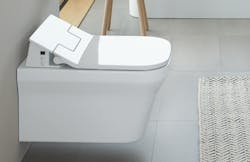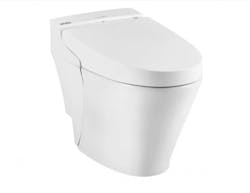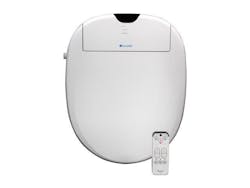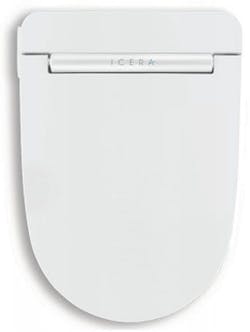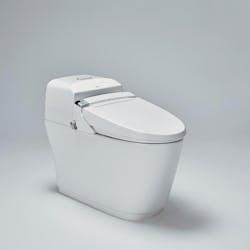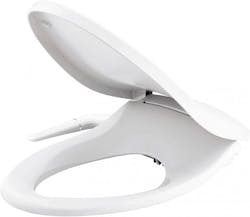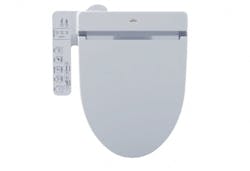Is the Bidet Poised for a Surge in the U.S. Market?
The U.S. is one of the regions across the globe where a bidet toilet is not popular, but the COVID-19 pandemic and design trends appear to be changing that.
Bidet unpopularity or indifference among American consumers has been a puzzle for many years, and many in the industry have long pondered the reason for that.
“Bathrooms and toilets around the world commonly feature a bidet or some type of water cleansing device like a spray hose like toilets in the Middle East commonly feature,” San Francisco-based Benjamin Franklin Plumbing has written on its company blog. “Yet bidets are curiously absent in the United States. With daily showers, daily hair washing, ubiquitous antibacterial soap, all sorts of hand sanitizers, and a dizzying array of toiletry products, Americans are known for being hygiene obsessed. Why have bidets not caught on in the United States when they are a common feature for toilets around the world?”
[ Related: Kohler Unveils New Intelligent Toilet That Runs on Batteries ]
American Standard Advanced Clean Smart Toilet
The answer could be quite simple, say Timothy Schroeder, president at Duravit USA: People in this country simply weren’t potty trained on a bidet.
“It’s not unusual for us to ask someone that’s wanting to order a bidet, have you ever used a bidet, and most people in our bath culture would say no,” Schroeder says. “In many cases, they don’t know how to use it.”
What is a Bidet?
So what exactly is a bidet? A bidet is a personal cleansing toilet that uses a warm water shower to clean the body, says the National Center for Biotechnology Information at the U.S. National Library of Medicine in Bethesda, Md. Popular in many parts of the world, such as Asia, Europe, The Middle East, and Latin America. For many years, a bidet was a separate product in the bathroom, but manufacturers developed the bidet shower seat, and it has been a game-changer (sort of) in the U.S. market.
Brondell Swash 900 RW Bidet Toilet Seat
“The electronic bidet seat has opened up the access to the function of a bidet in your bathroom on your toilet, rather than a separate fixture,” says Schroeder, whose company has always sold stand-alone separate bidets to the European, Latin American or Asian market. “[B]ut with the advent of the electronic bidet seat, that has brought the bidet technology to the American bath culture in a very compact, easy-to-adapt kind of way.”
If the bidet seat was the catalyst for acceptance in the U.S. market, the coronavirus pandemic has kicked that trend into high gear.
In the legitimate mass panic that ensued from COVID-19, American consumers flocked to stores and found shortages of toilet paper, as panic-buying and supply chain disruptions grew. Bidet seat manufacturers say many consumers have been looking to the bidet products as an alternative to toilet paper.
[ Related: 2020 Toilet Guide: 21 Efficient Products That Have Your Back—and Behind ]
Icera iWash bidet Seat
Considering the benefits, bidet seat manufacturer Brondell says, “upgrading to an electronic bidet seat, now could be a great time to get on board and finally ditch your toilet paper habit for good.” The company says there are many different options, models, and price points on the market today, so it’s easier than ever to find the right bidet product.
“The pandemic supercharged the visibility and awareness of the category because of the toilet paper situation,” Schroeder says. “As radically strange as that sounds, I think there was a hot rush to the market to adapt this technology because it doesn’t completely remove the need for toilet paper, but it greatly reduces the need.”
Another reason bidets are growing in popularity in the U.S. market is because of the advent of the smart toilet. Usually found on the upper end of the market, smart toilets feature a long list of innovations, including heated seats, automatic lid open and close, automatic flush, music, and integrated bidet functionality.
[ Related: Bio Bidet Introduces Competitively Priced High-Tech Smart Toilet ]
Inax S400 Smart Toilet
On the market for about 10 years, smart toilets have become popular with homeowners and kitchen and bath designers. According to HOUZZ’s recent Bathroom Trends Study, homeowners are increasingly interested in smart toilets for their master bathroom renovations. Thirty-four percent of toilets installed in a renovation are high-tech, up 6 percent from last year, according to the HOUZZ survey. Self-cleaning toilets and bidets are the top tech features in demand, but consumers are also benefiting from the other tech apps.
Smart toilets with integrated bidets are available from Kohler, Toto USA, Inax USA, Bio Bidet, Duravit, Icera, American Standard, DXV, and many more. These units tend to be pricey—as high as $7,000—but some manufacturers are making an effort to bring prices down.
Manufacturers have been busy. Kohler is now on multiple generations of its Numi smart toilet, which comes with an LCD touchscreen; built-in bidet and deodorizer; automatic open-and-close lid; built-in music system; and a heated seat and foot warmer.
Kohler Puretide Manual Bidet Seat
Duravit offers a wide selection of bidet seats and between 40 and 45 toilets that are capable of providing bidet function. Bio Bidet recently introduced a smart toilet that’s priced at $2,400; and Kohler has introduced a smart toilet that runs on AA batteries, while the company also offers a manual bidet seat that does not require power at all.
If you are choosing a smart toilet or a bidet unit for your clients, Schroeder recommends evaluating other features in addition to the cleansing function. Does it offer a water-saving flush? Does it offer a forward-thinking design? Does it blend into the design of the space? The same can be said for the bidet seat, especially when it comes to the design of the unit.
“One of the things that we introduced to the market is a concealed supply and that changed the orientation to the bidet seat because it started to look less like an appliance and more like a part of the toilet,” Schroeder explains.
The Future of the Bidet
The future looks bright for the bidet and bidet seat. The industry is expecting the U.S. market to grow 15 percent. “If you think about the features and benefits that a bidet seat bring,” Schroeder says, “it’s no longer just for somebody that’s potty trained on a bidet, no longer for somebody that has some kind of health ailment or needs, and no longer just for women, no longer just for the elderly, and no longer just for non-able-bodied people. It’s for everybody.”
TOTO Washlet+ C100 Bidet Seat
